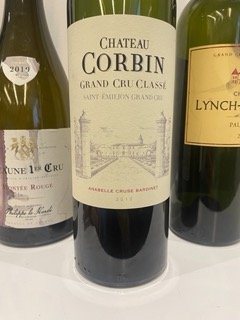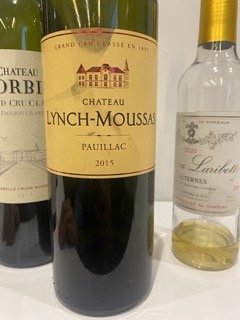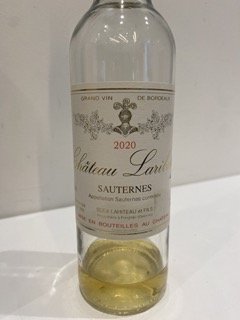Wine Tasting: Bordeaux
One thing to know (and remember) about Bordeaux is that over 90% of Bordeaux wines are red wines made with Merlot and Cabernet Sauvignon (the first vines for these grapes originated in Bordeaux). Red wines for Bordeaux are medium to full-bodied with aromas of black currant, plums, earthy notes of wet gravel, graphite and violet. The taste is often savory, with mouth-drying tannins. The tannins are typically high enough to allow the wines to age several decades. When we talk about Bordeaux vintages (and this is one of the ways to find a Bordeaux steal in value), typically they come around 1-2x every five years.
Bordeaux Blanc, Esprit de Saint-Sulpice, 2021
I am impartial to dry, tangy, sometimes, fruity Sauvignon Blancs from New Zealand. However, have never tasted a Bordeaux White! I was pleasantly surprised by this Sauvignon Blanc (80%) and Sémillon (20%) blend and might have to try a few more ;)
White Bordeaux are wonderfully flavorful, complex, elegant and the result of a selection of only nine varietals (as dictated by French law) to be used in the production of the blended white. In addition to Sauvignon Blanc and Sémillon, Muscadelle also reigns superior in the varietals used (the other six being used a bit less lately).
Young yellow, almost pale green. Intense aroma and flavor of green apple and pineapple. Light and bright with a short, mouthwatering finish. Fresh and grassy tasting with notes of grapefruit, lime and green apple.
Saint-Émilion, Grand Cru Classé, Château Corbin, 2015
The sub region of Saint Émilion in Bordeaux is recognized across the globe by wine experts as one of the world’s premier wine producing areas. It’s primarily associated with the production of high quality, flavorful blended red wines, with the blending techniques and methods having been passed down through generations to maintain the reputation and popularity of Saint Emilion wines. Most are Merlot based with additions of Cabernet Franc and Cabernet Sauvignon.
Planted in one single block, the Corbin vineyard is located in the north west of the Saint Emilion appellation, just next to Pomerol. Chateau Corbin is one of the oldest estates in Saint Emilion - dating back to the 15th century. Two soils make up the vineyard - ancient sands surrounding the château over an iron-rich clay sub soil, giving wine delicacy and finesses; while clay on the Pomerol side of the estate brings the wine it’s richness. On average, the age of the vines is 30 years.
As is the tradition of Bordeaux estates, Chateau Corbin also passes down the chateau via lineage. However, one thing I find particularly interesting is that their line of succession has been passed down from mother to daughter, for multiple generations (maybe that’s why the wine is so refined and elegant! 😉)
Deep, jammy red fruits on the nose with a hint of cedar. Medium body with medium tannins. Medium acid, and slight savory taste. Notes of cherry, and softer, ripe black fruits.
Pauillac, Château Lynch-Moussas, 5me Cru Classé, 2015
Bordeaux Pauillac wines are rich and concentrated, full-bodied reds with grippy tannins with notes of cassis, cedar and cigar box spice. A quintessential Bordeaux red would be a blend with a base of high-quality Cabernet Sauvignon. Pauillac is located on Bordeaux’s Left Bank Médoc region and has well-draining gravel soils, which translates to high quality wine (which age very well).
Gorgeous, dark red in color. Herbal bouquet, slightly fruity, oaky with notes of espresso. Medium to full-bodied with smooth tannins. Good acidity and full of dark fruits like black currant, plum and cherries. Long, lingering finish.
Sauternes, Château Laribotte, 2019
Château Laribotte is a family estate that dates back six generations - back to the end of the French Revolution. Located in the village of Preignac, south of Bordeaux, on the left bank of the Garonne river, mists cover the vines every morning creating the perfect conditions for botrytis cinerea fungus AKA “noble rot”. This gives the sweet wines of Sauternes their uniquely complex, concentrated character.
As a result of noble rot, the wine is rich in sugar as well as residual sugar, and is fermented for about 3 weeks. Grapes are handpicked late - when they’re overripe - and when their juices are further concentrated by noble rot. This makes the grape skins more permeable, allowing their water to evaporate and aromas and sugars to concentrate. On average age of the vines is 60 years old. This Sauternes is 90% Semillon, 8% Sauvignon and 2% Muscadelle.
Brilliant golden color. Aromatic notes of flowers, honey, lemon and peach jam. Fruity and candied flavors, and notes of dry apricot. Long finish and slightly acidic. This would pair well with foie gras, white cheeses and savory desserts.



